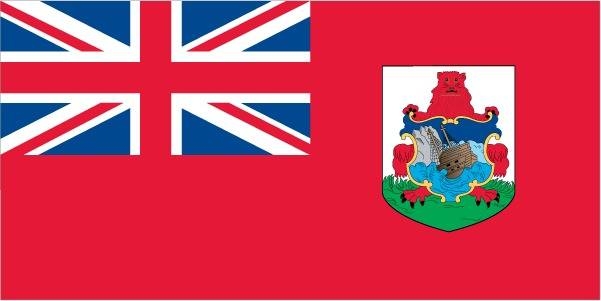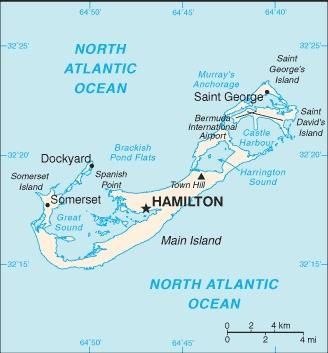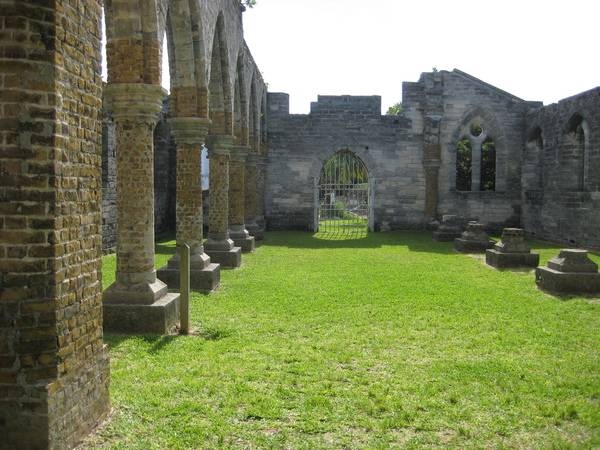116 Bermuda (UK)

Red, with the flag of the UK in the upper hoist-side quadrant and the Bermudian coat of arms (a white shield with a red lion standing on a green grassy field holding a scrolled shield showing the sinking of the ship Sea Venture off Bermuda in 1609) centered on the outer half of the flag. It was the shipwreck of the vessel, filled with English colonists originally bound for Virginia, that led to the settling of Bermuda.
Flag courtesy of the CIA World Factbook

Map courtesy of the CIA World Factbook


Bermuda’s “Unfinished Church” – what would have been St. George Church – fell victim to three events that precluded its use. The Gothic 650-seat church, designed by William Hay, began construction in 1874 as a replacement for the storm-damaged St. Peter’s church. During the construction the congregation split, which halted work on the church. Funds were later diverted to build a new cathedral in Hamilton after the old one burned down. Private donations finished the church in 1899, but the rejoined congregation returned to old St. Peter’s. In 1926, a storm damaged the church leaving it in its present condition. The “Unfinished Church” is maintained by the Bermuda National Trust.
Photos courtesy of the CIA World Factbook
Last updated on October 27, 2025
Government
According to Britannica, Bermuda is an internally self-governing British overseas territory with a parliamentary government. Under its 1968 constitution, the British monarch, represented by the governor, is the head of state. The governor maintains control over external affairs, defense, internal security, and the police but acts on the advice of the cabinet, led by the premier, who is head of government and of the majority party in the legislature. The bicameral legislature is composed of the House of Assembly, with 36 members elected to terms of up to five years, and the Senate, with 11 members appointed by the governor (5 on the advice of the premier, 3 on the advice of the leader of the opposition, and 3 at the governor’s discretion). The Supreme Court heads the judicial system. The system of local government comprises nine parishes: St. George’s, Hamilton, Smith’s, Devonshire, Pembroke, Paget, Warwick, Southampton, and Sandys.
Bermuda Civil Aviation Authority (BCAA)
The Bermuda Civil Aviation Authority (BCAA) is responsible for the regulation and safety oversight of aviation in Bermuda and all aircraft on the Bermuda Aircraft Registry. The BCAA was formed 1st October 2016 having previously operated as the Bermuda Department of Civil Aviation, which was established in 1931. Bermuda is a United Kingdom Overseas Territory and though it is regulated by the UK Department for Transport, the safety oversight system is separate from that of the UK. The regulatory requirements are established in the Air Navigation (Overseas Territories) Order (AN(OT)O). Overseas Territory Aviation Requirements (OTARs) provide an acceptable means of compliance with the AN(OT)O. The regulations/requirements are fully compliant with the standards and recommended practices of the ICAO. Bermuda’s Aircraft Registry is extensive and ranks 10th in size when compared to the 193 signatory States to the Convention on International Civil Aviation (also referred to as the Chicago Convention). The current Aircraft Registry includes a mix of both private aircraft and commercial aircraft operated on a Bermuda Air Operator’s Certificate (AOC)or under Article 83 bis Agreements of the Convention on International Civil Aviation.
Airspace
SkyVector – Google Maps – ADS-B Exchange
ICAO countries publish an Aeronautical Information Publication (AIP). This document is divided into three parts: General (GEN), En Route (ENR) and Aerodromes (AD). ENR 1.4 details the types of airspace classes they chose to adopt from classes A through G.
Drone Regulations
ASSI – Legal requirements for the operation of small unmanned aircraft in the UK Overseas Territories
Advanced Air Mobility (AAM) Regulations & Policies
None found by the author.
However, should you, the reader, happen to stumble across something to the contrary, please email the author at FISHE5CA@erau.edu and you may be mentioned in the ACKNOWLEDGEMENTS section of this book by way of thanks for contributing to this free eBook!
Advanced Air Mobility (AAM) News
None found by the author.
However, should you, the reader, happen to stumble across something to the contrary, please email the author at FISHE5CA@erau.edu and you may be mentioned in the ACKNOWLEDGEMENTS section of this book by way of thanks for contributing to this free eBook!
Short Essay Questions
Scenario-Based Question
You have been hired by a Drone Startup Company. Your boss has immediately assigned this job to you.
They need you to prepare a one-page memo detailing the legalities of using a drone to film Bermuda’s unfinished church, pictured above.
They need you to mention any national laws and local ordinances.
They specifically want to know what airspace (insert pictures) you will be operating in and whether or not you need an airspace authorization.
Does it matter whether or not you are a citizen of the country?
Lastly, there is a bonus for you if, as you scroll through this chapter, you find any typos or broken links!
Short Essay Questions
- What are the drone categories?
- How is registration addressed?
- How is remote ID addressed?
- What are the model aircraft rules?
- What are the commercial drone rules?
- Are there waivers or exemptions to the rules? If so, for what?
- Would you share a link to an interactive airspace map?
- How is BVLOS addressed?
- How can you fly drones at night?
- How can you fly drones over people?
- Where do you find drone NOTAMs?
- What are the rules for drone maintenance?
- What are the rules for an SMS program?
- What are some unique rules not mentioned above?
- What are the C-UAS rules?
- What are the AAM rules?

